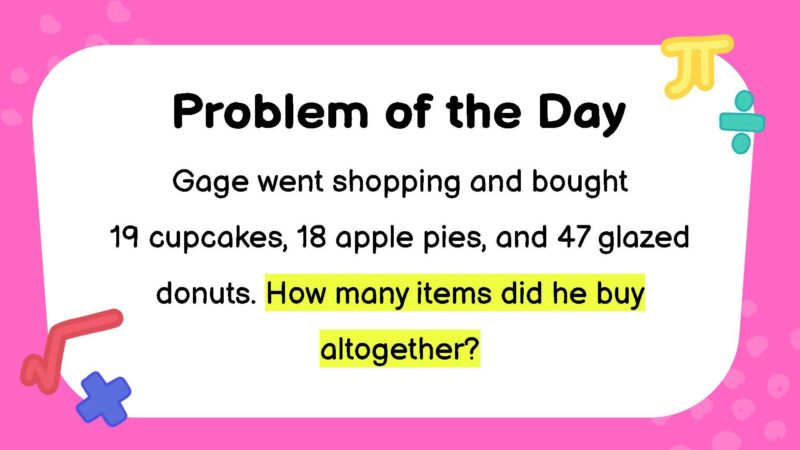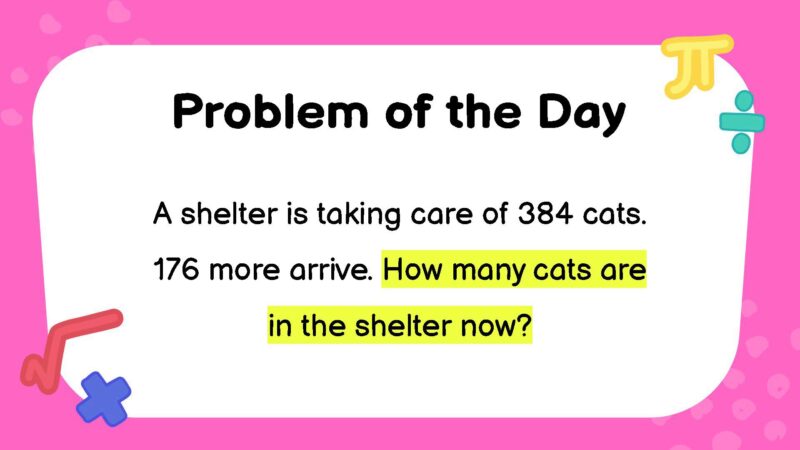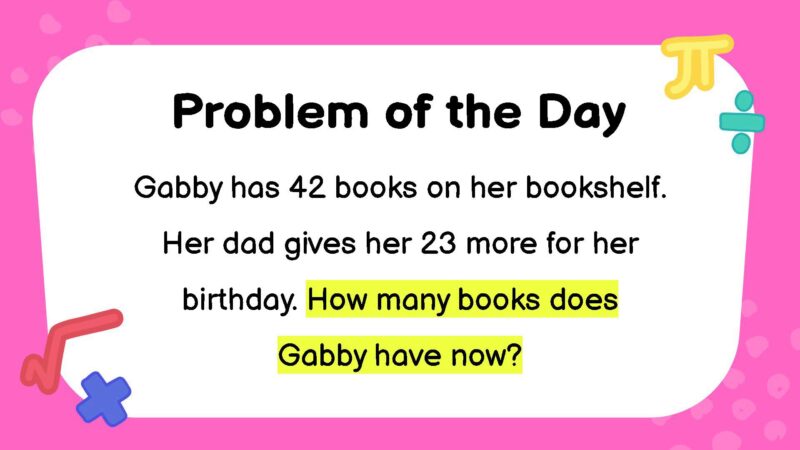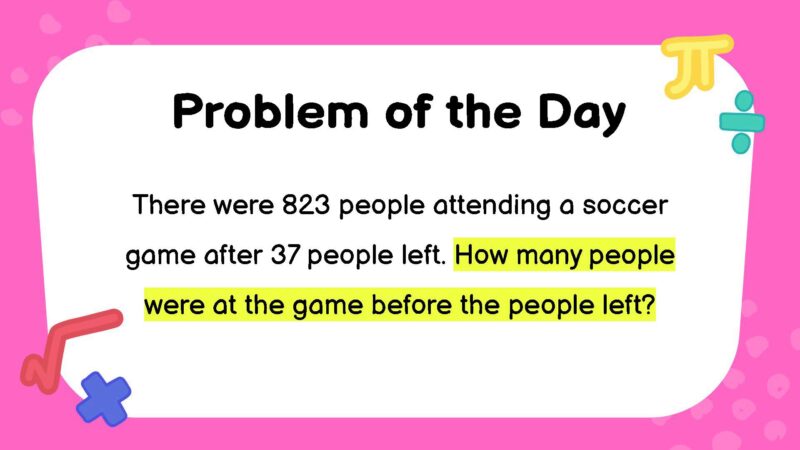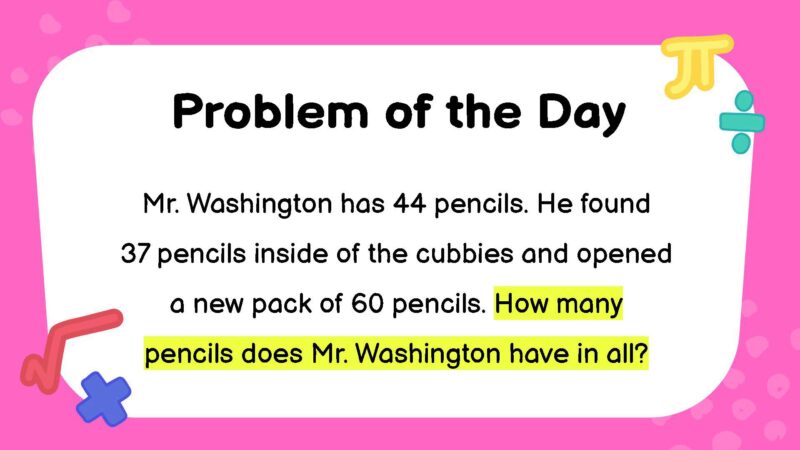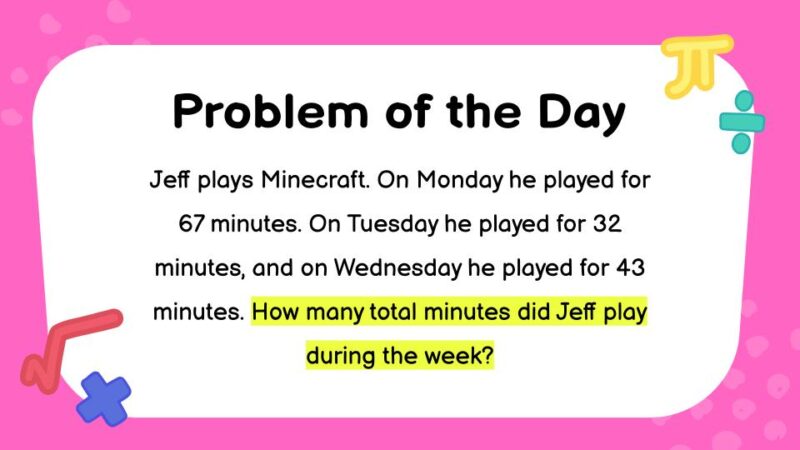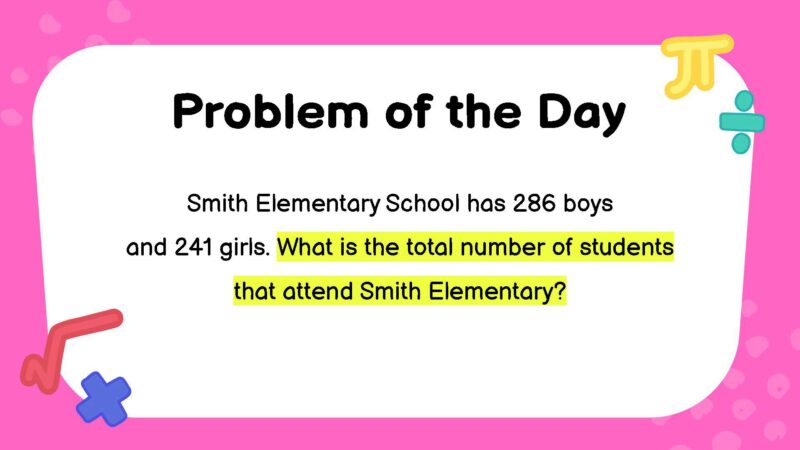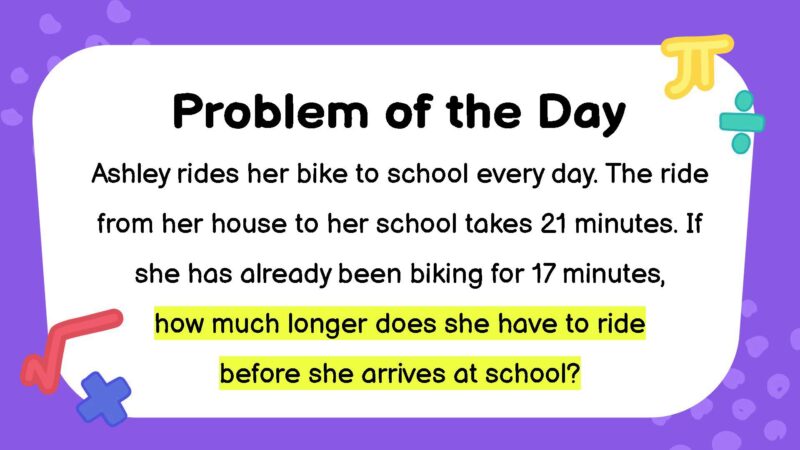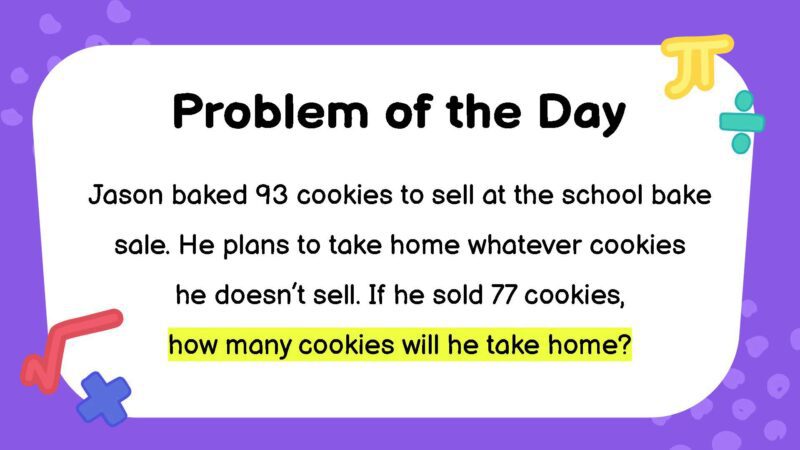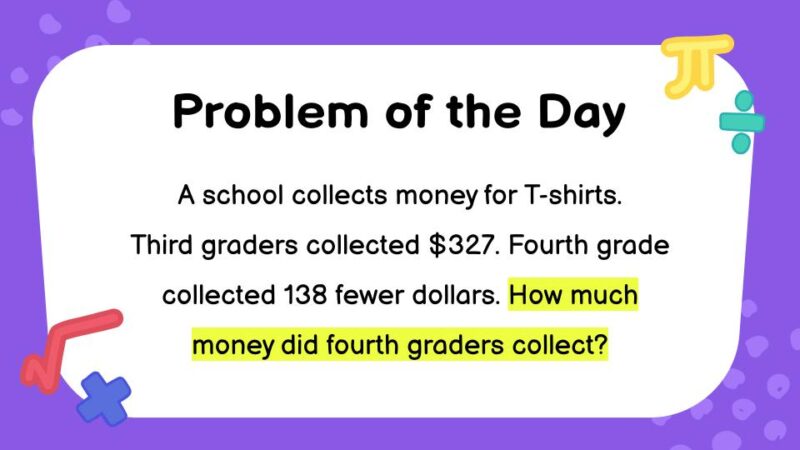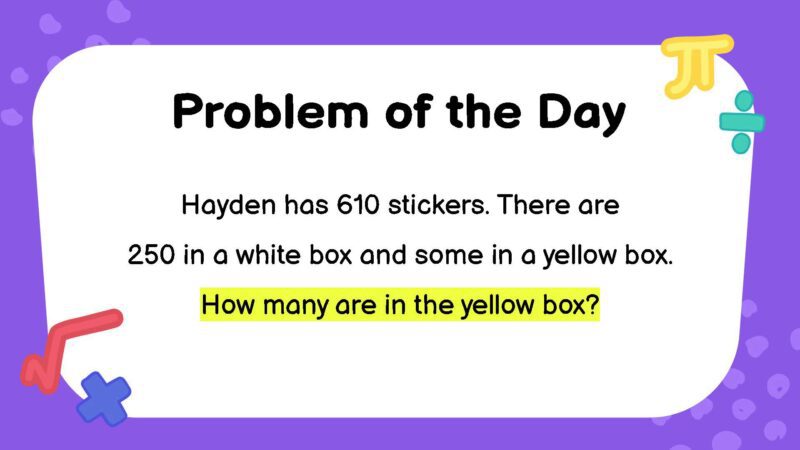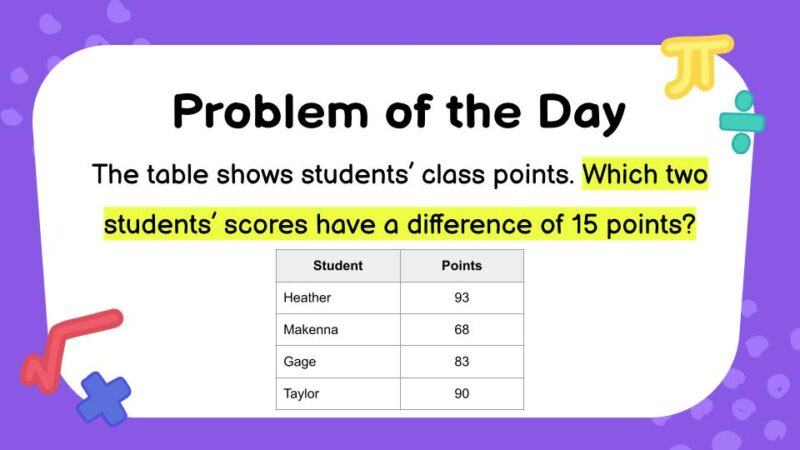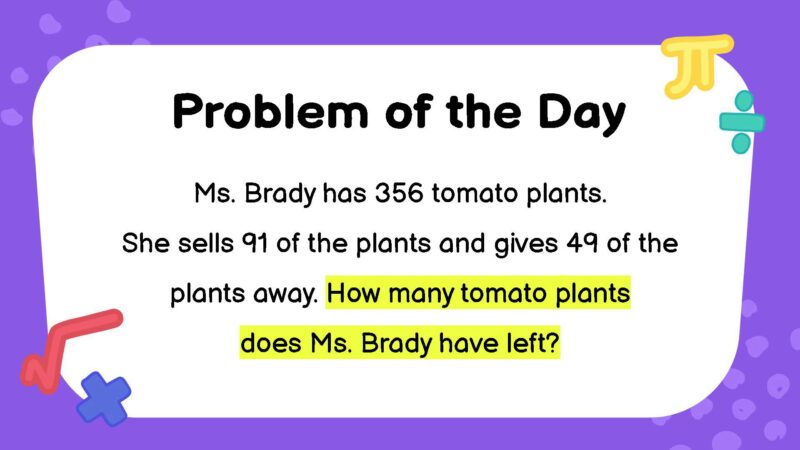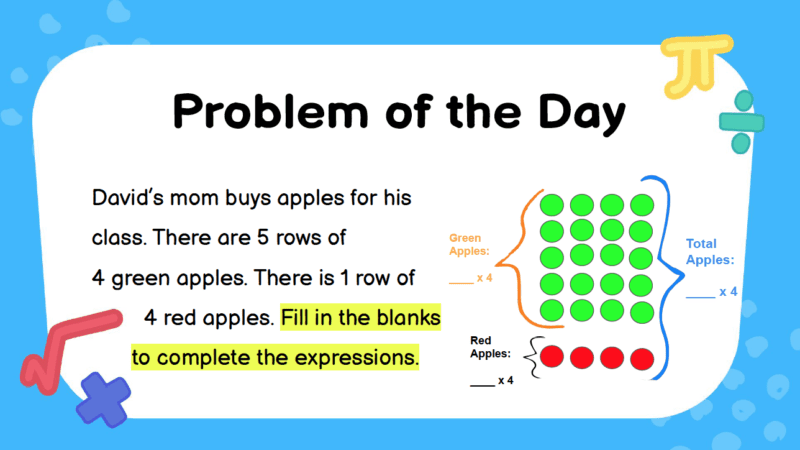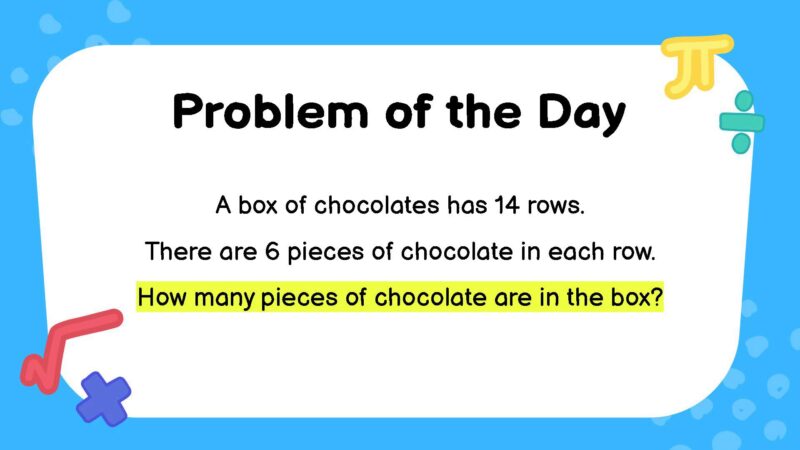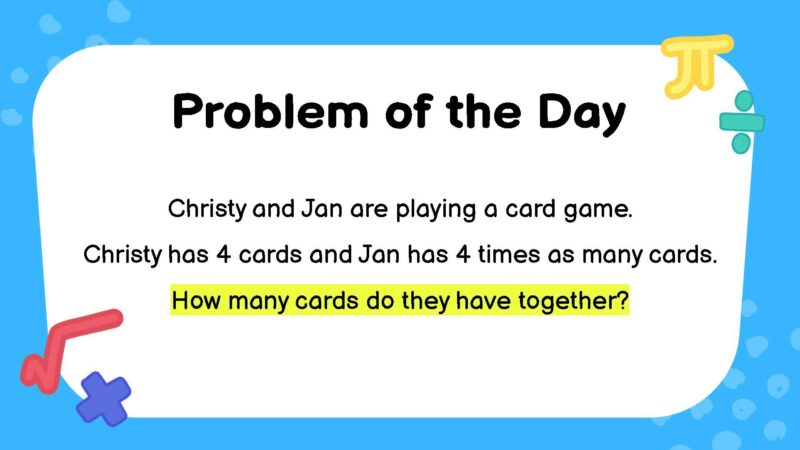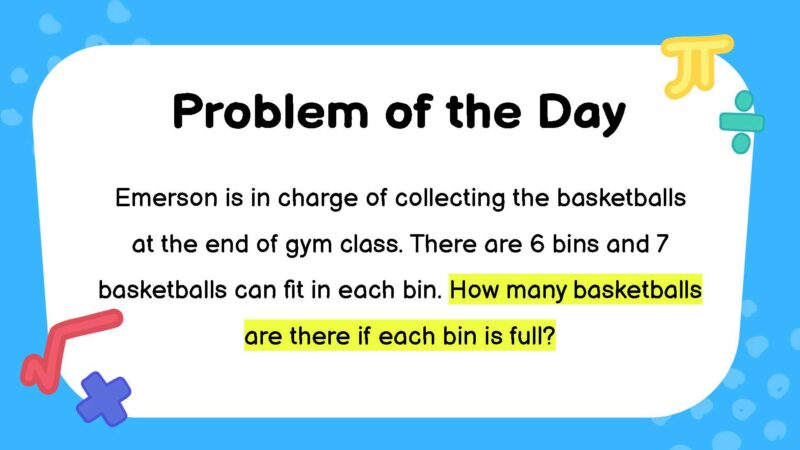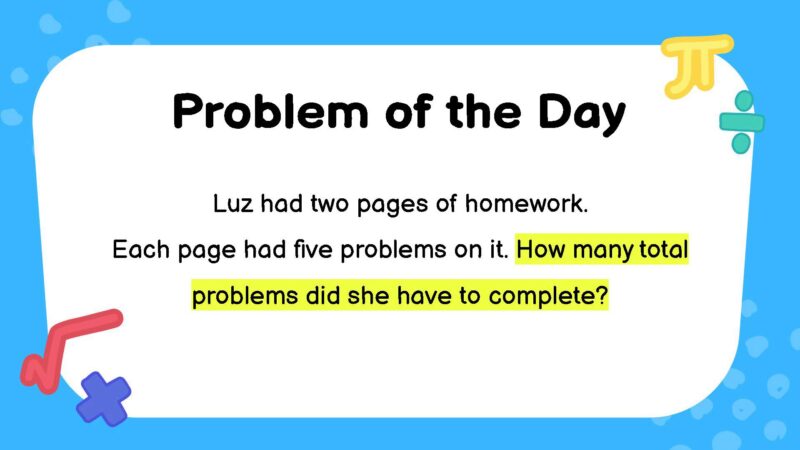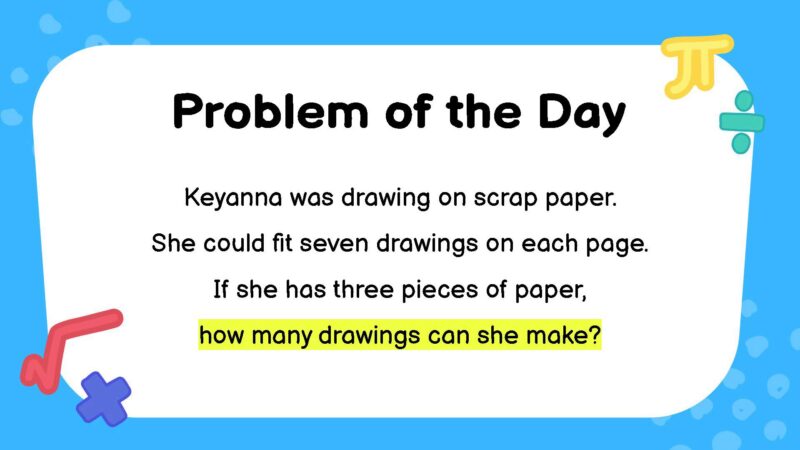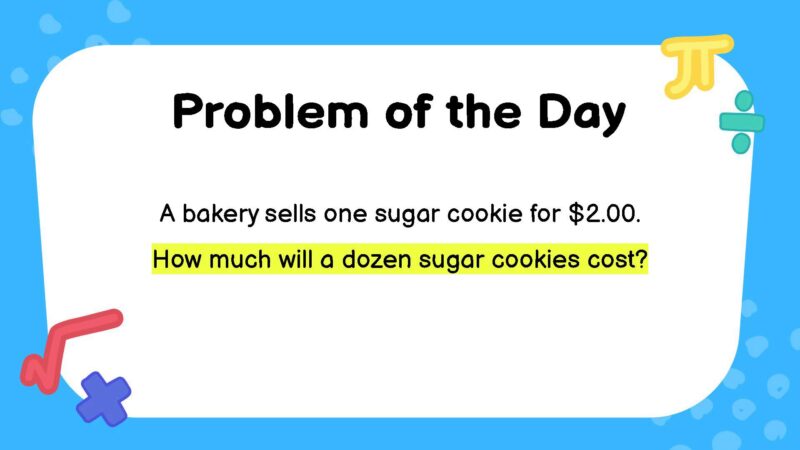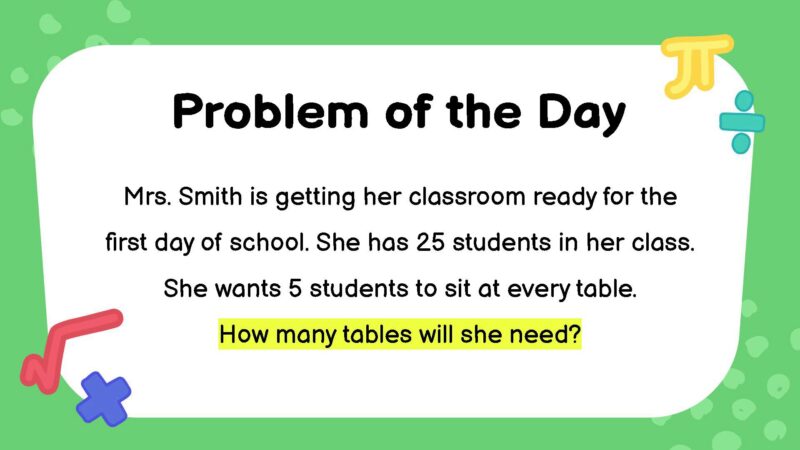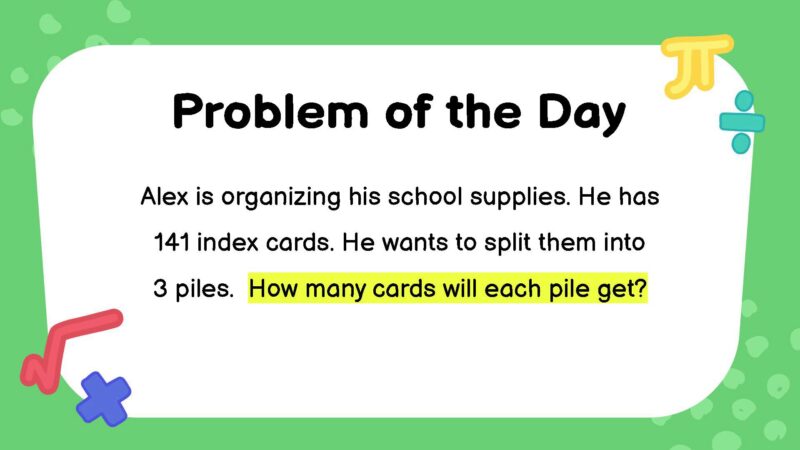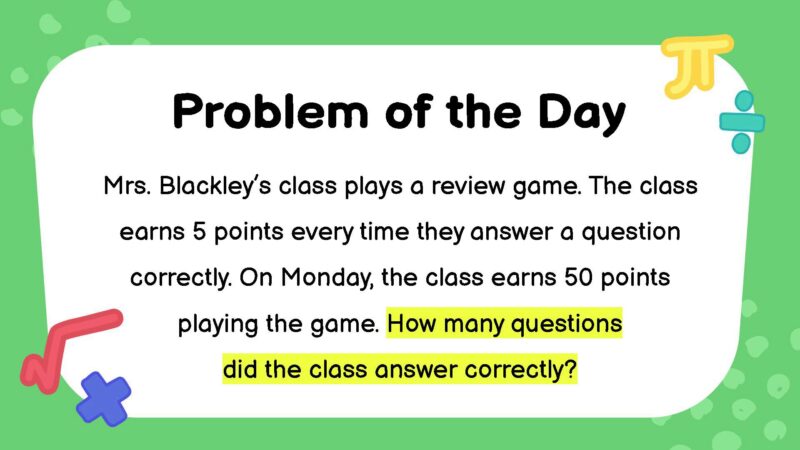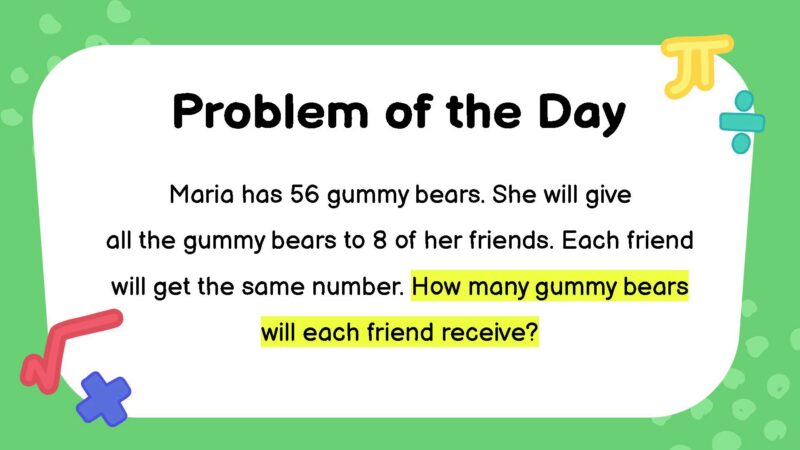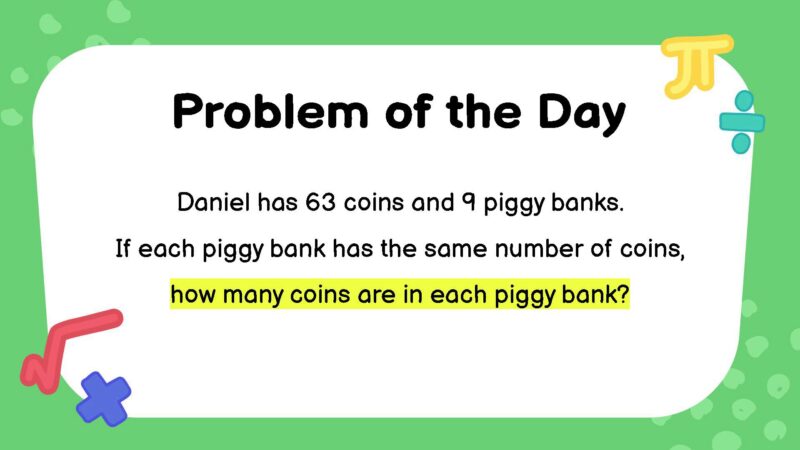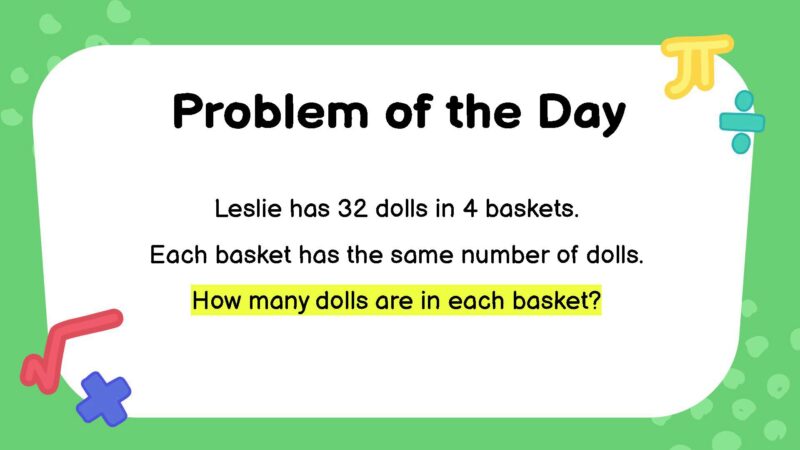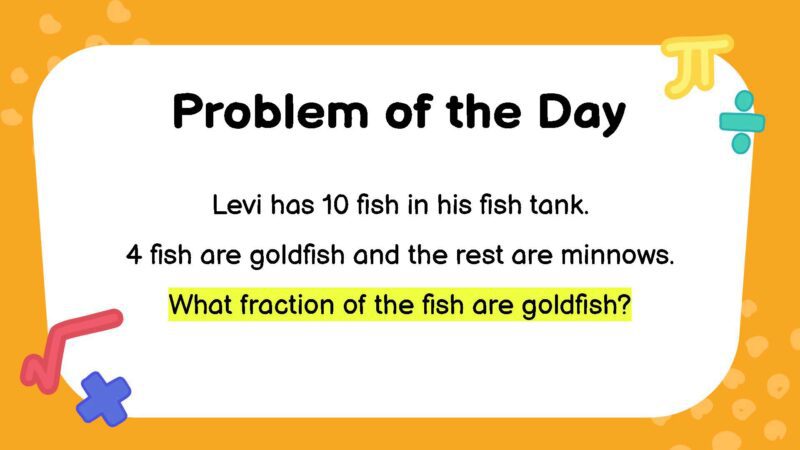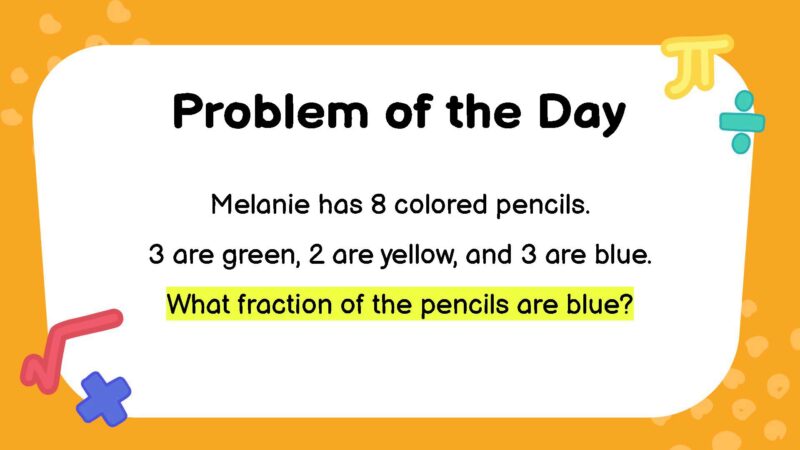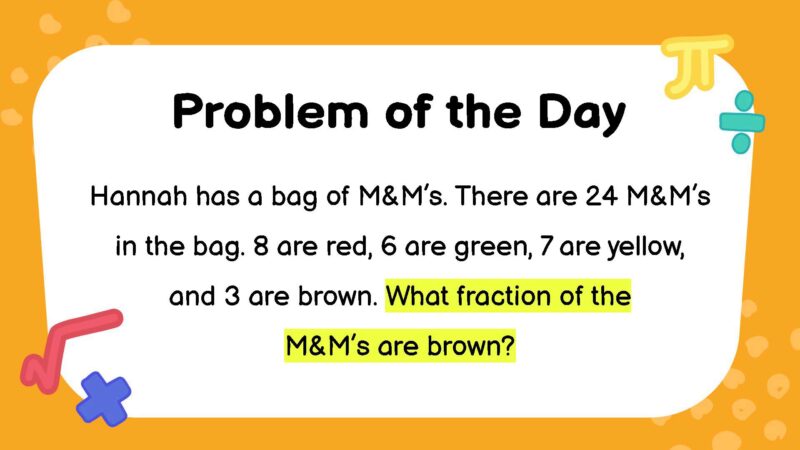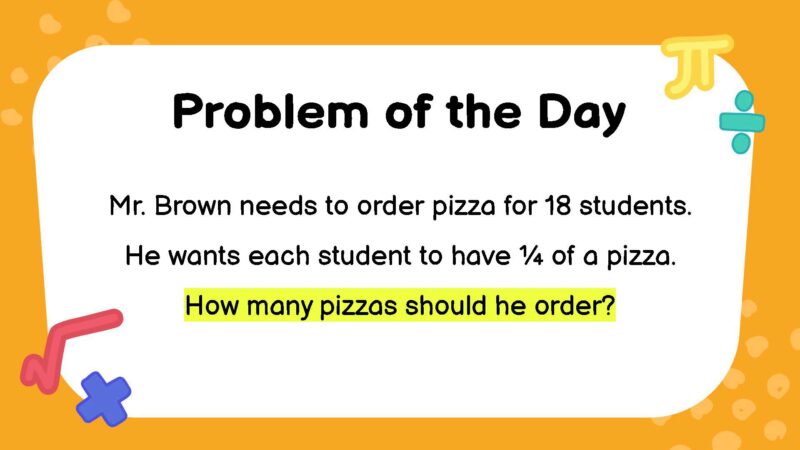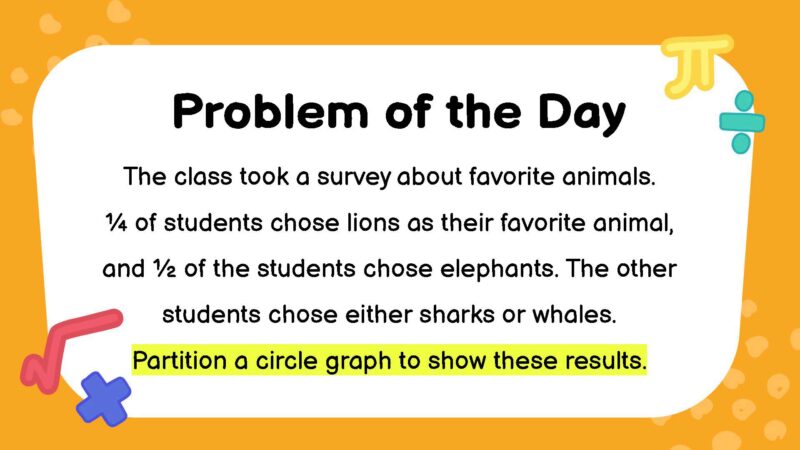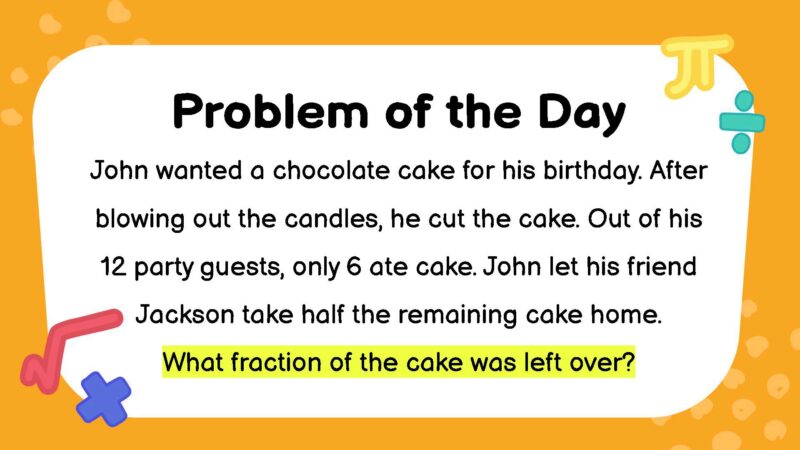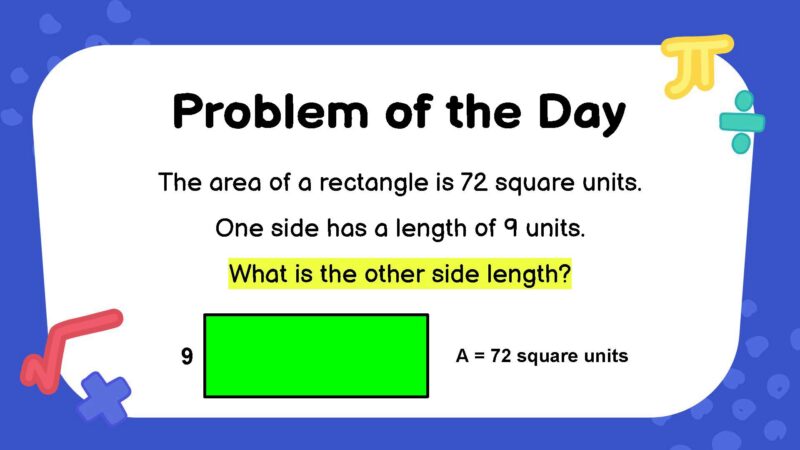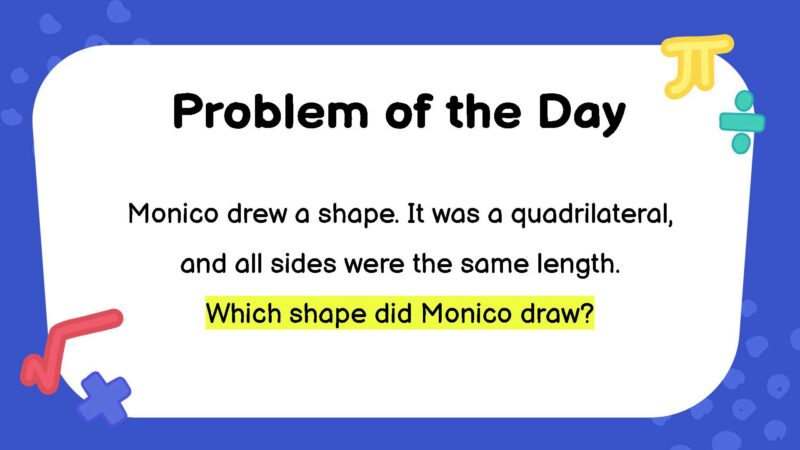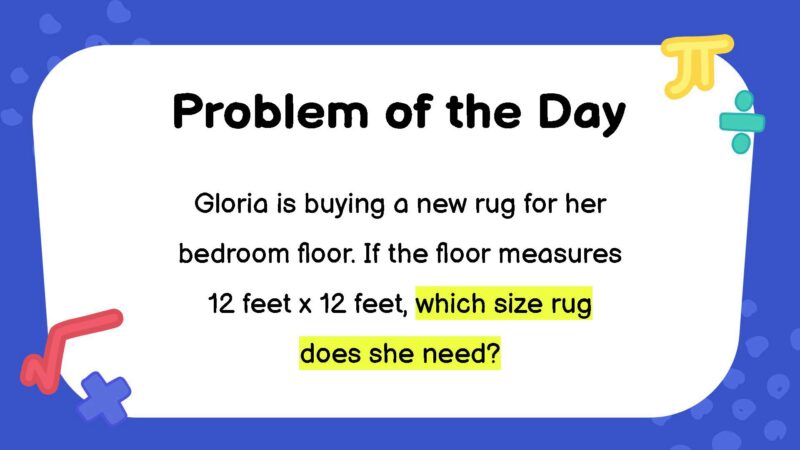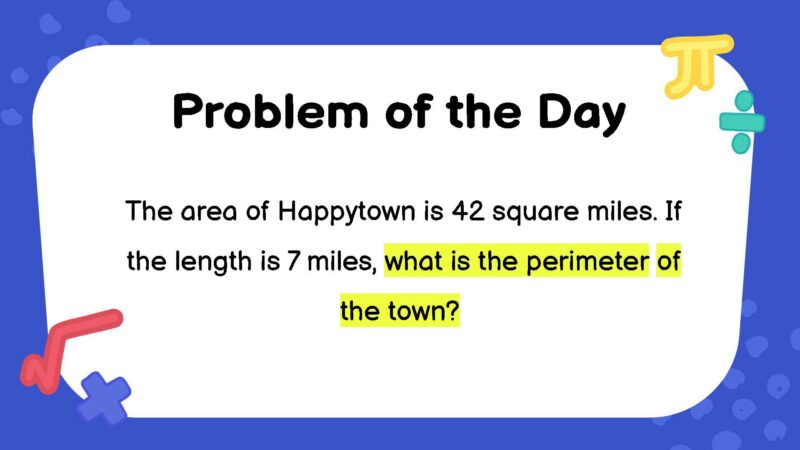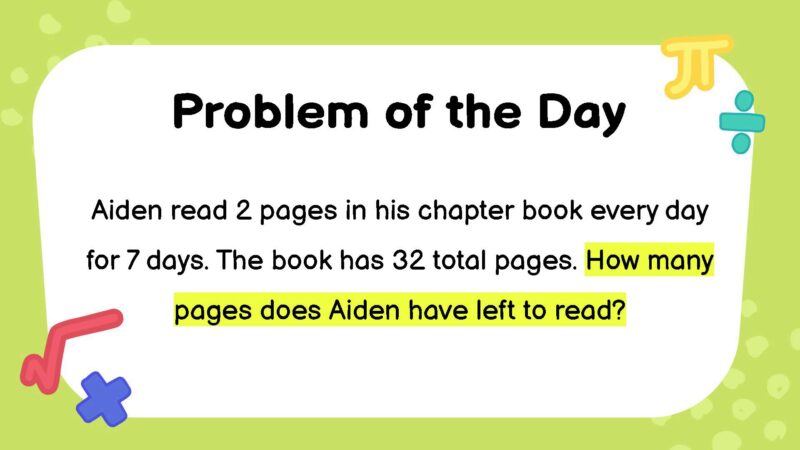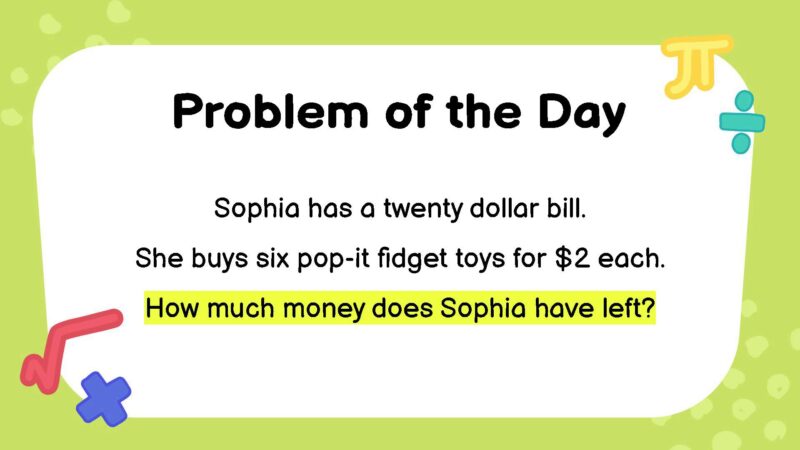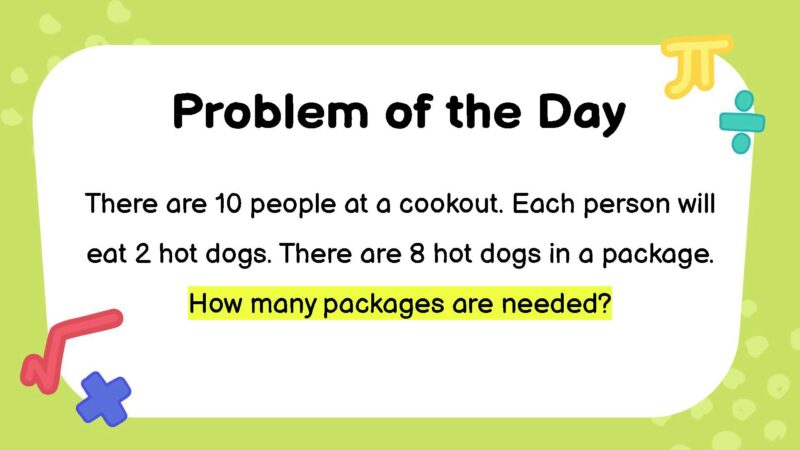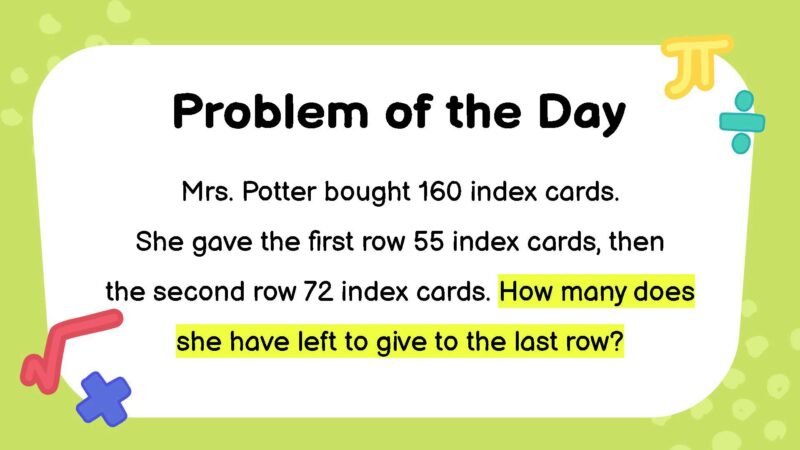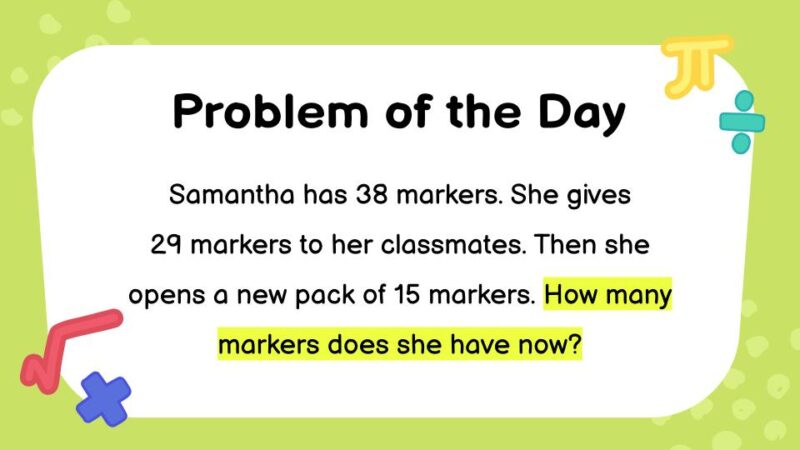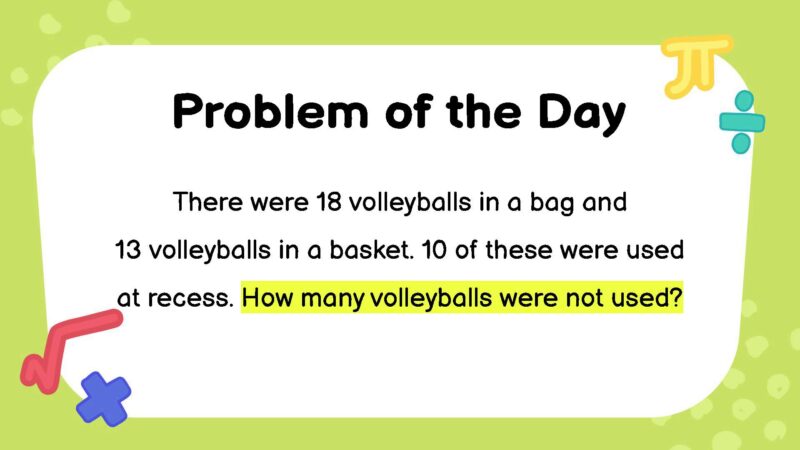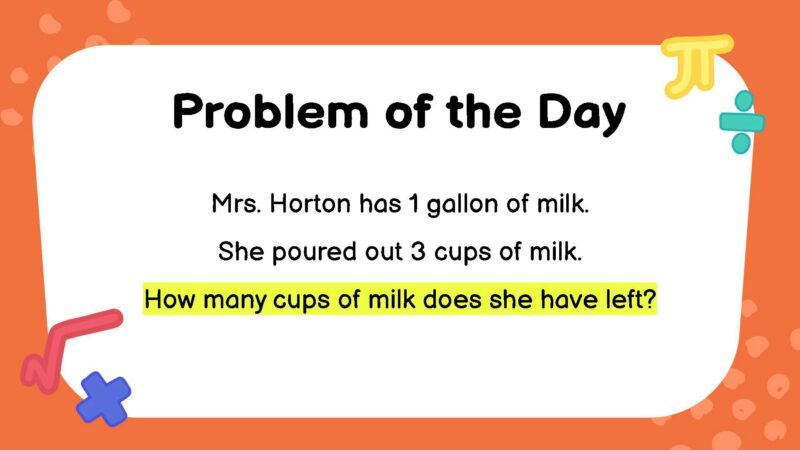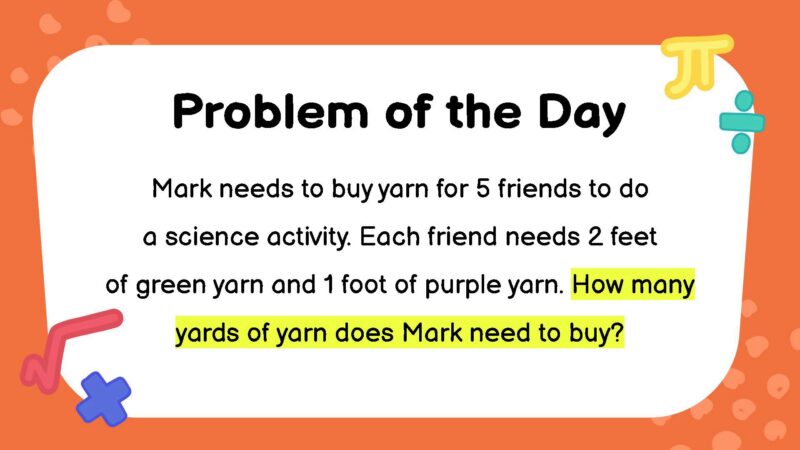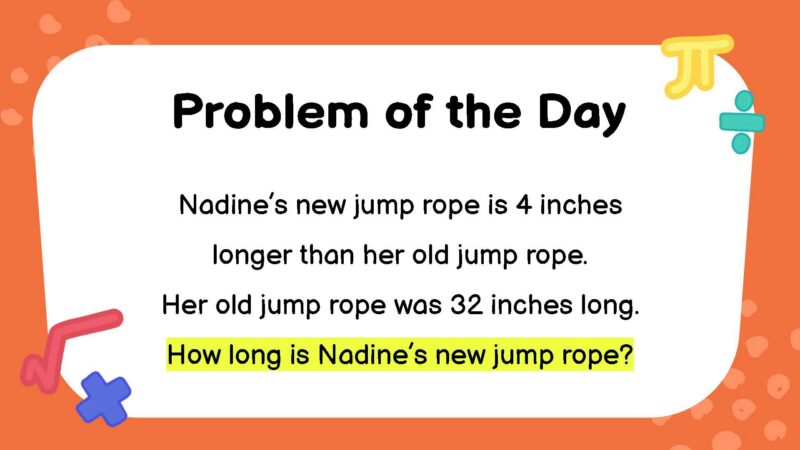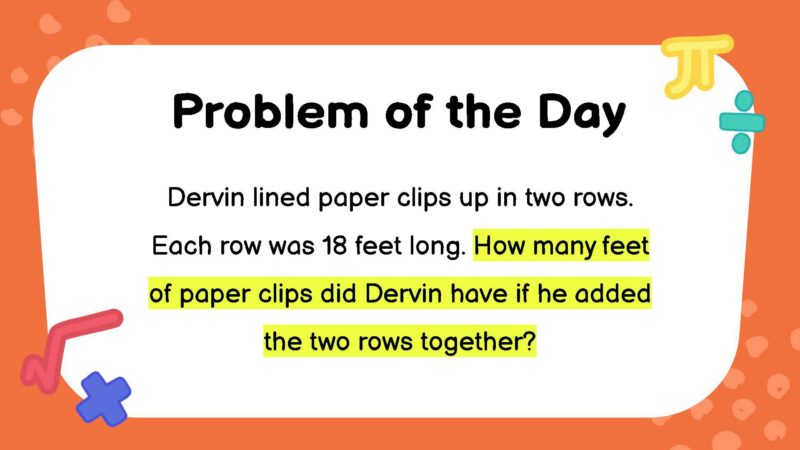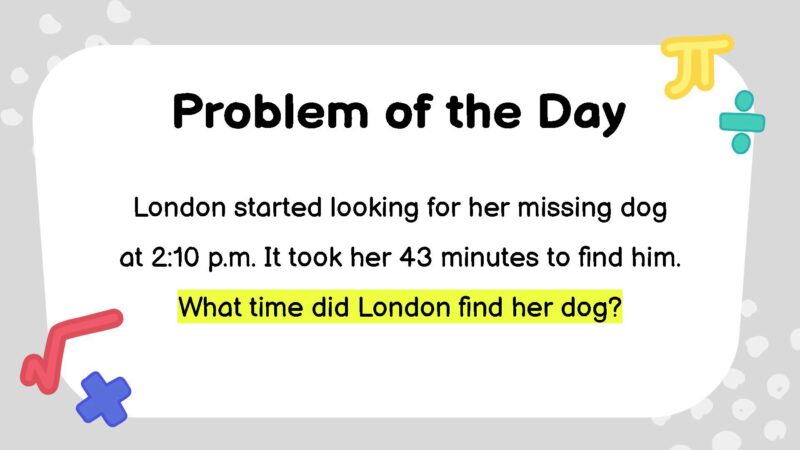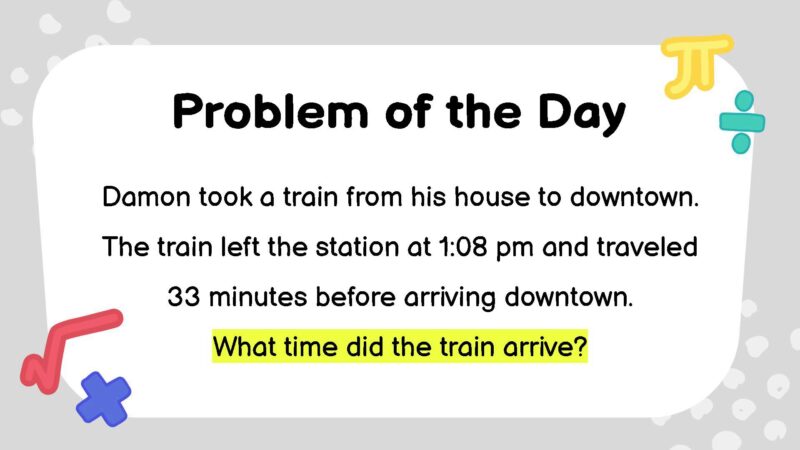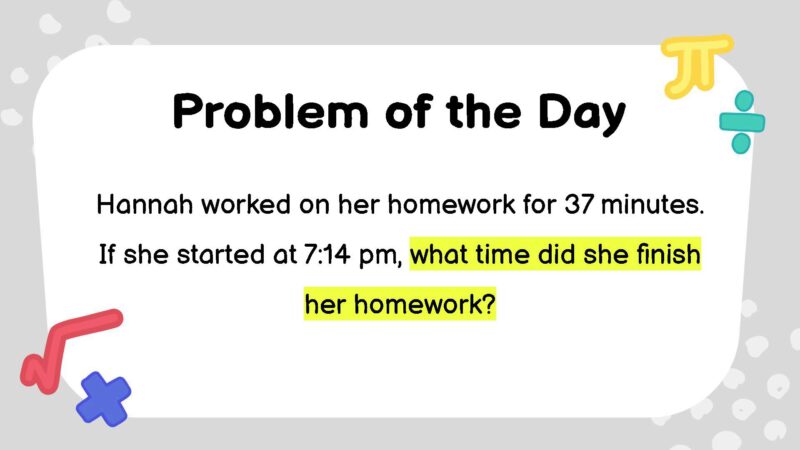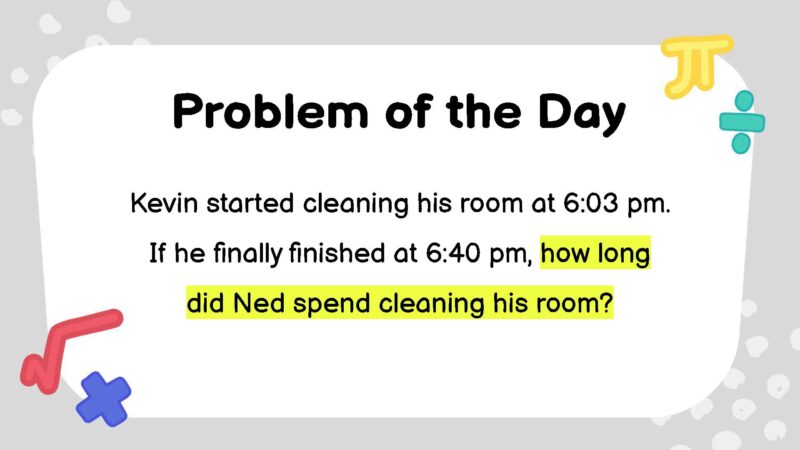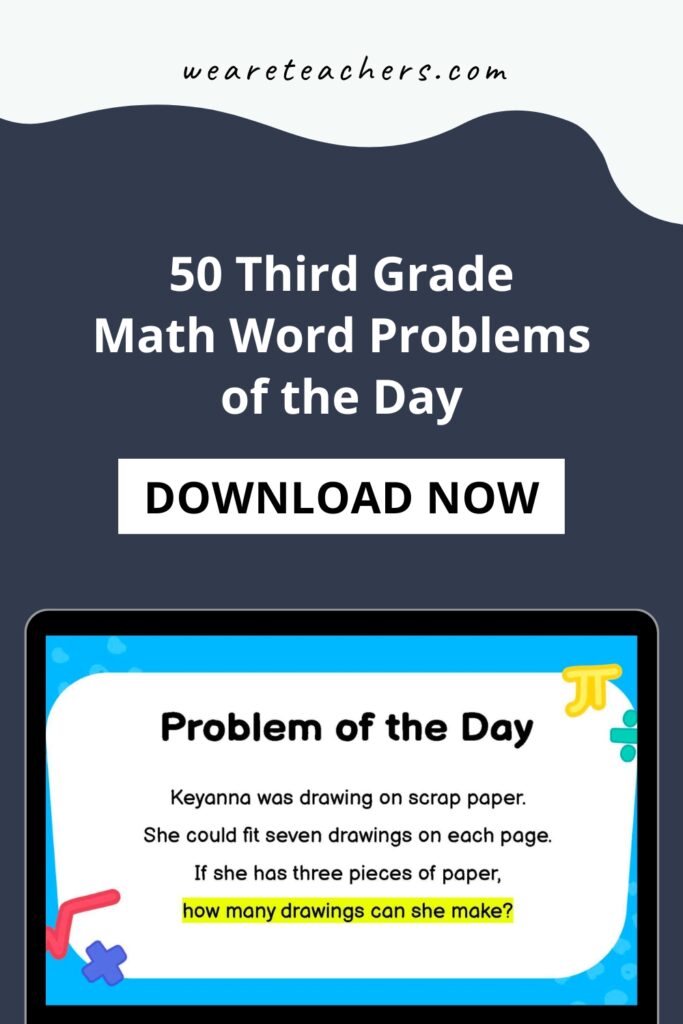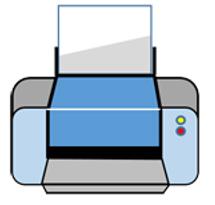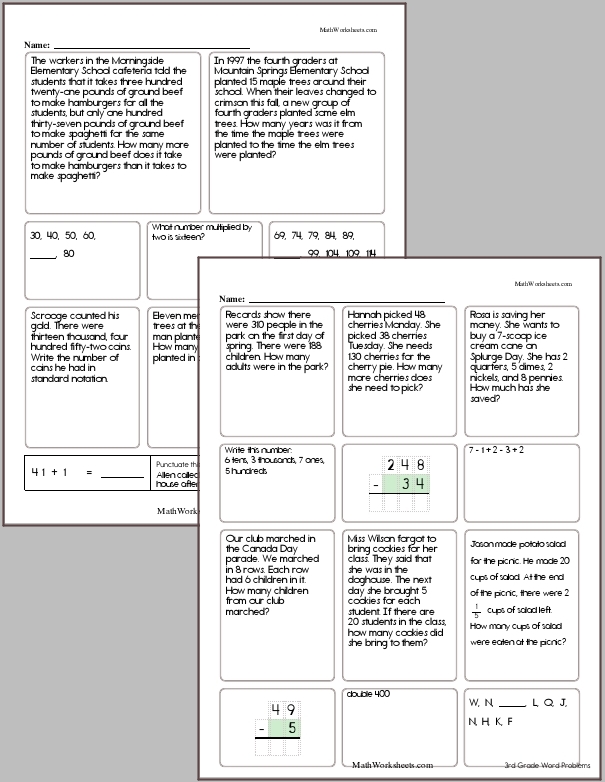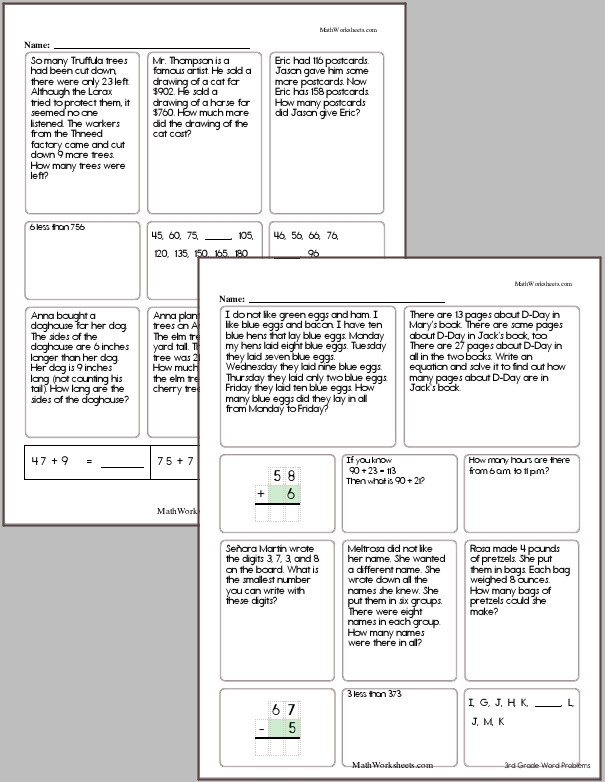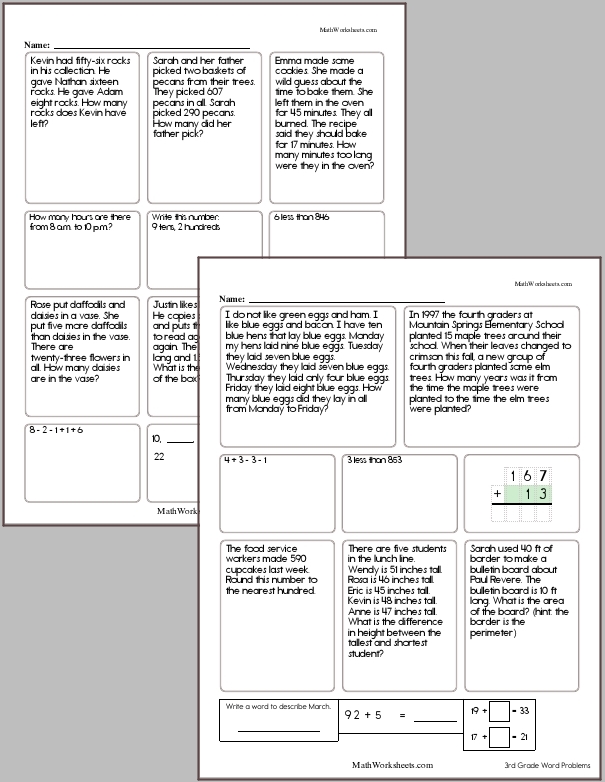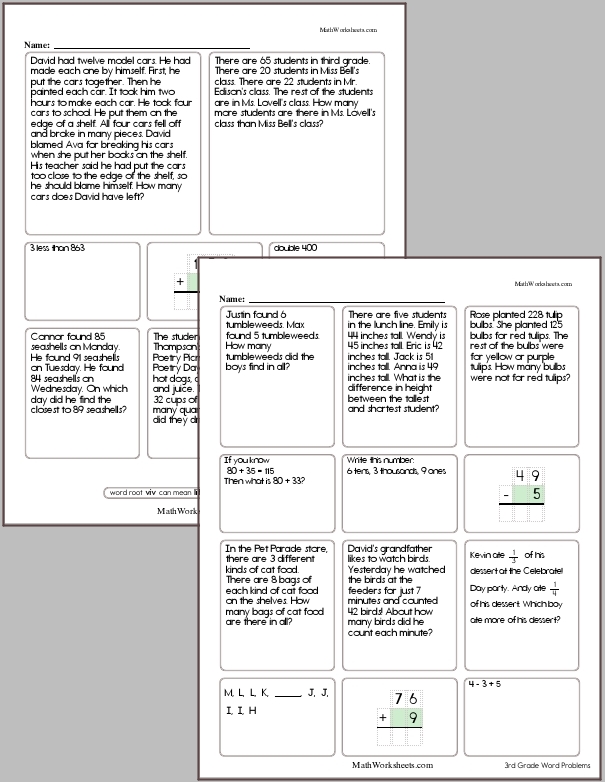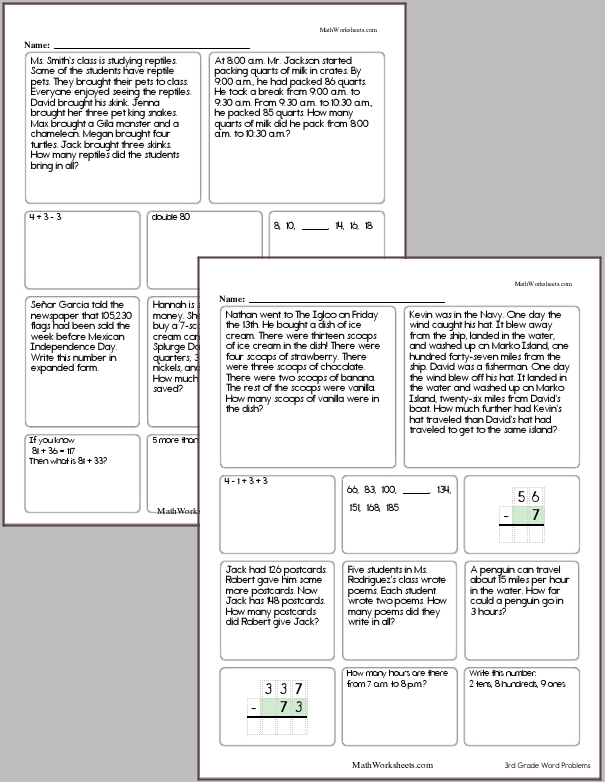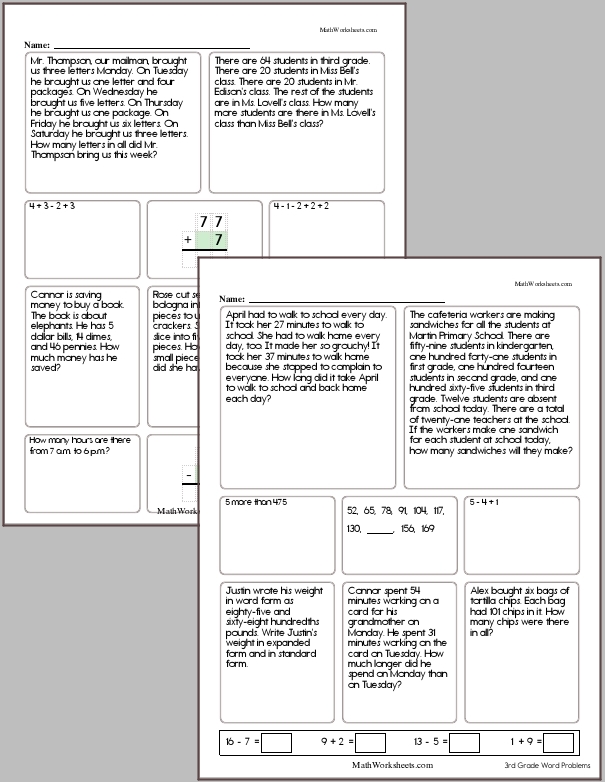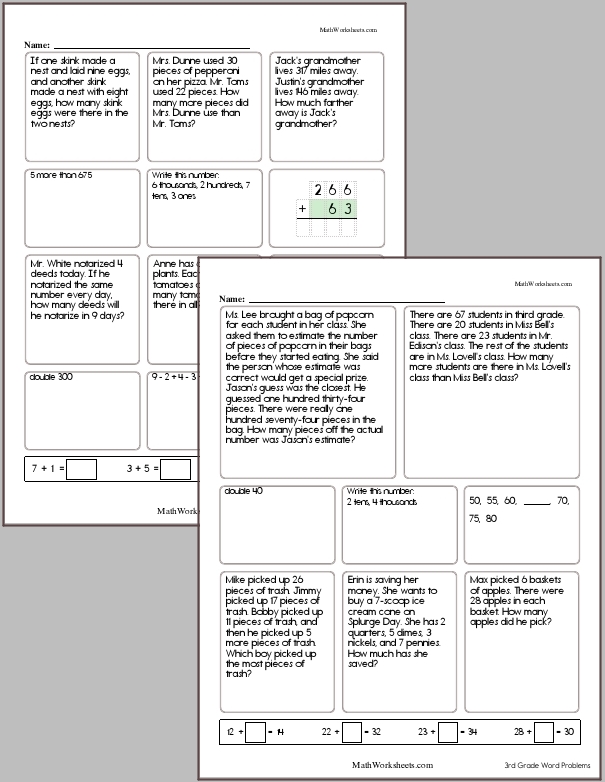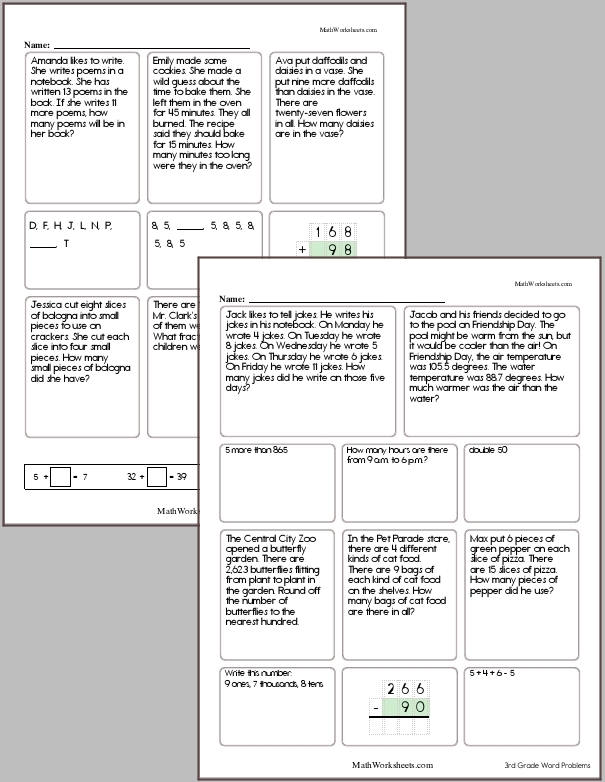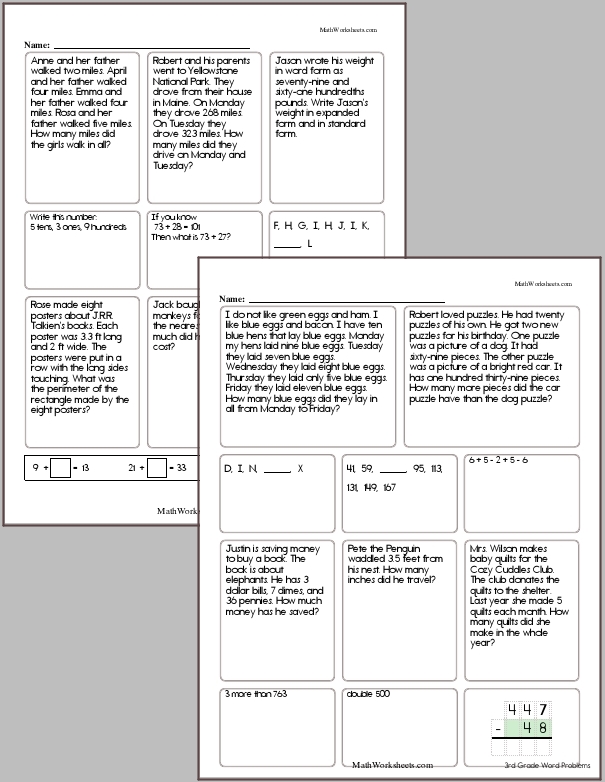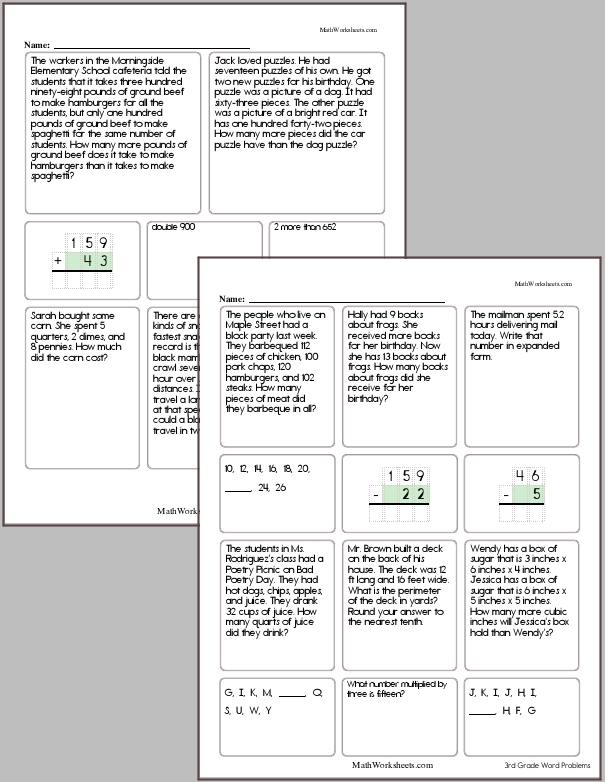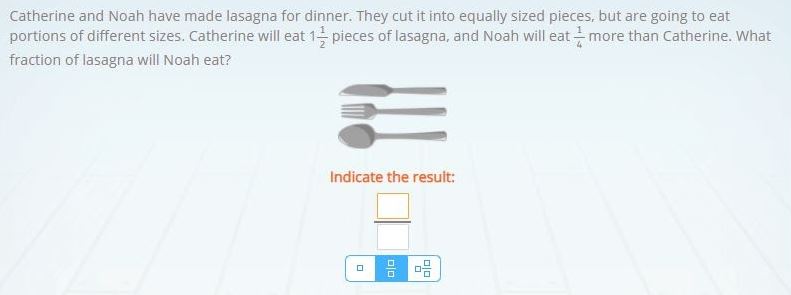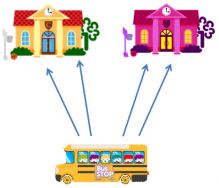Word problems for third grade
Math word problems help deepen a student’s understanding of mathematical concepts by relating mathematics to everyday life.
These worksheets are best attempted after a student has studied the underlying skill; for example, our ‘addition in columns» word problem worksheets should not be attempted until students are comfortable with addition in columns.
In many of our word problems we intentionally include superfluous data, so that students need to read and think about the questions carefully, rather than simply applying a computation pattern to solve the problems.
Addition word problems for third grade
Simple addition word problems
Column form addition word problems
Mixed add and subtract word problems
Subtraction word problems
Simple subtraction word problems
Subtraction in columns word problems
Multiplication word problems
Simple multiplication word problems
Multiples of 10
Multiplying in columns
More multiplication word problems
Mixed multiply & divide word problems
Division word problems
Simple division word problems
Long division word problems
Fraction word problems
Identifying and comparing fractions word problems
Adding and subtracting fractions word problems
Mixed 3rd grade word problems
The following worksheets contain a mix of grade 3 addition, subtraction, multiplication and division word problems. Mixing math word problems tests the understanding mathematical concepts, as it forces students to analyze the situation rather than mechanically apply a solution.
Mixed word problems — mental math
Mixed word problems — column math
Mixed word problems — simpler form (shorter texts, no superfluous data)
Measurement word problems for grade 3
These word problems combine the 4 operations with real world units of length, time, volume and mass. There is no conversion of units.
Length word problems
Time word problems
Mass & weight word problems
Volume & capacity word problems.
Word problems with variables
These grade 3 word problems introduce students to using variables («x, y, etc.») to represent unknowns. The problems are relatively simple, but emphasize the use of variables and the writing of equations.
Word problems with variables (variable is chosen for the student)
Writing variables to solve word problems (student chooses the variable)
Opening your daily math lesson with a Math Word Problem of the Day is an excellent way to set the stage for learning. We all know that word problems are difficult for young learners to grasp, even when the mathematical operation portion of the problem is basic. Incorporate these third grade math word problems one day at a time at the start of your math block to build confidence, critical thinking skills, and a learning community. Students will get used to reading slowly for meaning, while also identifying key information. Encourage students to write out equations and draw pictures to explain their thinking, since this helps them see the light when they are stuck!
Topics covered include addition, subtraction, multiplication, division, mixed operation, fractions, area and perimeter, and measurement. All you need to do is post one of these third grade math word problems on your whiteboard or projector screen, then let kids take it from there.
Want this entire set of word problems in one easy document? Get your free PowerPoint bundle by submitting your email here.
1. Gage went shopping and bought 19 cupcakes, 18 apple pies, and 47 glazed donuts. How many items did he buy altogether?
2. A shelter is taking care of 384 cats. 176 more arrive. How many cats are in the shelter now?
3. Gabby has 42 books on her bookshelf. Her dad gives her 23 more for her birthday. How many books does Gabby have now?
4. There were 823 people attending a soccer game after 37 people left. How many people were at the game before the people left?
5. Mr. Washington has 44 pencils. He found 37 pencils inside of the cubbies and opened a new pack of 60 pencils. How many pencils does Mr. Washington have in all?
6. Jeff plays Minecraft. On Monday he played for 67 minutes. On Tuesday he played for 32 minutes, and on Wednesday he played for 43 minutes. How many total minutes did Jeff play during the week?
7. Smith Elementary School has 286 boys and 241 girls. What is the total number of students that attend Smith Elementary?
8. Ashley rides her bike to school every day. The ride from her house to her school takes 21 minutes. If she has already been biking for 17 minutes, how much longer does she have to ride before she arrives at school?
9. Jason baked 93 cookies to sell at the school bake sale. He plans to take home whatever cookies he doesn’t sell. If he sold 77 cookies, how many cookies will he take home?
10. A school collects money for T-shirts. Third graders collected $327. Fourth graders collected 138 fewer dollars. How much money did fourth graders collect?
11. Hayden has 610 stickers. There are 250 in a white box and some in a yellow box. How many are in the yellow box?
12. The table shows students’ class points. Which two students’ scores have a difference of 15 points?
13. Ms. Brady has 356 tomato plants. She sells 91 of the plants and gives 49 of the plants away. How many tomato plants does Ms. Brady have left?
14. David’s mom buys apples for his class. There are 5 rows of 4 green apples. There is 1 row of 4 red apples. Fill in the blanks to complete the expressions.
15. A box of chocolates has 14 rows. There are 6 pieces of chocolate in each row. How many pieces of chocolate are in the box?
16. Christy and Jan are playing a card game. Christy has 4 cards and Jan has 4 times as many cards. How many cards do they have together?
17. Emerson is in charge of collecting the basketballs at the end of gym class. There are 6 bins, and 7 basketballs can fit in each bin. How many basketballs are there if each bin is full?
18. Luz had two pages of homework. Each page had five problems on it. How many total problems did she have to complete?
19. Keyanna was drawing on scrap paper. She could fit seven drawings on each page. If she has three pieces of paper, how many drawings can she make?
20. A bakery sells one sugar cookie for $2.00. How much will a dozen sugar cookies cost?
21. Mrs. Smith is getting her classroom ready for the first day of school. She has 25 students in her class. She wants 5 students to sit at every table. How many tables will she need?
22. Alex is organizing his school supplies. He has 141 index cards. He wants to split them into 3 piles. How many cards will each pile get?
23. Mrs. Blackley’s class plays a review game. The class earns 5 points every time they answer a question correctly. On Monday, the class earns 50 points playing the game. How many questions did the class answer correctly?
24. Maria has 56 gummy bears. She will give all the gummy bears to 8 of her friends. Each friend will get the same number. How many gummy bears will each friend receive?
25. Daniel has 63 coins and 9 piggy banks. If each piggy bank has the same number of coins, how many coins are in each piggy bank?
26. Leslie has 32 dolls in 4 baskets. Each basket has the same number of dolls. How many dolls are in each basket?
27. Levi has 10 fish in his fish tank. 4 fish are goldfish and the rest are minnows. What fraction of the fish are goldfish?
28. Melanie has 8 colored pencils. 3 are green, 2 are yellow, and 3 are blue. What fraction of the pencils are blue?
29. Hannah has a bag of M&M’s. There are 24 M&M’s in the bag. 8 are red, 6 are green, 7 are yellow, and 3 are brown. What fraction of the M&M’s are brown?
30. Mr. Brown needs to order pizza for 18 students. He wants each student to have ¼ of a pizza. How many pizzas should he order?
31. The class took a survey about favorite animals. ¼ of students chose lions as their favorite animal, and ½ of the students chose elephants. The other students chose either sharks or whales. Partition a circle graph to show these results.
32. John wanted a chocolate cake for his birthday. After blowing out the candles, he cut the cake. Out of his 12 party guests, only 6 ate cake. John let his friend Jackson take half the remaining cake home. What fraction of the cake was left over?
33. The area of a rectangle is 72 square units. One side has a length of 9 units. What is the other side length?
34. Monico drew a shape. It was a quadrilateral, and all sides were the same length. Which shape did Monico draw?
35. Gloria is buying a new rug for her bedroom floor. If the floor measures 12 feet x 12 feet, which size rug does she need?
36. The area of Happytown is 42 square miles. If the length is 7 miles, what is the perimeter of the town?
37. Aiden read 2 pages in his chapter book every day for 7 days. The book has 32 total pages. How many pages does Aiden have left to read?
38. Sophia has a twenty dollar bill. She buys six pop-it fidget toys for $2 each. How much money does Sophia have left?
39. There are 10 people at a cookout. Each person will eat 2 hot dogs. There are 8 hot dogs in a package. How many packages are needed?
40. Mrs. Potter bought 160 index cards. She gave the first row 55 index cards, then the second row 72 index cards. How many does she have left to give to the last row?
41. Samantha has 38 markers. She gives 29 markers to her classmates. Then she opens a new pack of 15 markers. How many markers does she have now?
42. There were 18 volleyballs in a bag and 13 volleyballs in a basket. 10 of these were used at recess. How many volleyballs were not used?
43. Mrs. Horton has 1 gallon of milk. She poured out 3 cups of milk. How many cups of milk does she have left?
44. Mark needs to buy yarn for 5 friends to do a science activity. Each friend needs 2 feet of green yarn and 1 foot of purple yarn. How many yards of yarn does Mark need to buy?
45. Nadine’s new jump rope is 4 inches longer than her old jump rope. Her old jump rope was 32 inches long. How long is Nadine’s new jump rope?
46. Dervin lined paper clips up in two rows. Each row was 18 feet long. How many feet of paper clips did Dervin have if he added the two rows together?
47. London started looking for her missing dog at 2:10 pm. It took her 43 minutes to find him. What time did London find her dog?
48. Damon took a train from his house to downtown. The train left the station at 1:08 pm and traveled 33 minutes before arriving downtown. What time did the train arrive?
49. Hannah worked on her homework for 37 minutes. If she started at 7:14 pm, what time did she finish her homework?
50. Kevin started cleaning his room at 6:03 pm. If he finally finished at 6:40 pm, how long did Ned spend cleaning his room?
If you like these third grade math word problems, check out our third grade hub for even more resources.
Get a PPT version of these word problems.
Word Problems
Welcome to our 3rd Grade Addition and Subtraction Word Problems page.
Here is our selection of free addition and subtraction word problem worksheets, which will help your child
practice solving a range of addition and subtraction problems using 3-digit and 4-digit numbers.
Quicklinks to …
- 3 Digit Addition & Subtraction Word Problems
- 4 Digit Addition & Subtraction Word Problems
- 2-Step Addition & Subtraction Word Problems
- Easier Addition & Subtraction Worksheets
- More related resources
- Addition & Subtraction Word Problems up to 1000 Online Quiz
3rd Grade Addition and Subtraction
3-digit and 4-digit Word Problems
Each sheet consists of a range of 5 addition and subtraction word problems with numbers up to thousands.
There is a space on each sheet for working out, so that your child can write out the problem and solve it.
We have split the worksheets up into 3-digit word problems and 4-digit word problems.
Using these sheets will help your child to:
- add and subtract numbers with 3-digit and 4-digit numbers;
- solve addition and subtraction word problems with and without regrouping.
- recognise the language used in addition and subtraction — sum, total, difference, how many more, etc.
- solve problems involving more than 1 step.
3rd Grade Addition and Subtraction Word Problems
3-digit Addition and Subtraction Word Problems
There are two versions of each sheet.
The first version (version A) contains problems where no regrouping is needed.
The second version (version B) contains similar problems but regrouping is needed to solve them.
Answers have been provided with each sheet, along with the calculation needed to solve the problem.
The following sheets are all 1-step addition or subtraction word problems.
-
3-Digit Addition and Subtraction Word Problems Sheet 1A (no regrouping)
-
Answers
-
PDF version
-
3-Digit Addition and Subtraction Word Problems Sheet 1B
-
Answers
-
PDF version
-
3-Digit Addition and Subtraction Word Problems Sheet 2A (no regrouping)
-
Answers
-
PDF version
-
3-Digit Addition and Subtraction Word Problems Sheet 2B
-
Answers
-
PDF version
4-digit Addition and Subtraction Word Problems
The word problems all involve either addition or subtraction (both with and without regrouping).
-
4-Digit Addition and Subtraction Word Problems Sheet 1
-
Answers
-
PDF version
-
4-Digit Addition and Subtraction Word Problems Sheet 2
-
Answers
-
PDF version
Harder 2-Step Addition and Subtraction Word Problems
These problems are trickier than those above.
Each problem involved two steps to solve, and may involve just addition, just subtraction or both operators.
There are 4 problems on each sheet, and more space to work out the solutions.
-
2-Step Addition Subtraction Problems up to 3-digits Sheet 1
-
Answers
-
PDF version
-
2-Step Addition Subtraction Problems up to 4-digits Sheet 1
-
Answers
-
PDF version
Looking for some easier worksheets?
Take a look at our Subtraction word problems for first graders.
On this page, your child will learn to work out basic subtraction word problems with numbers to 20.
More Recommended Math Worksheets
Take a look at some more of our worksheets similar to these.
More 3rd Grade Addition and Subtraction Worksheets
Here you will find some more of our Addition and Subtraction Worksheet generators for creating your own bespoke addition and subtraction worksheets.
More 3rd Grade Math Word Problems
Using the 3rd Grade Math worksheets will help your child to:
- apply their addition, subtraction, and multiplication skills;
- develop their knowledge of fractions;
- apply their knowledge of rounding and place value;
- solve a range of ‘real life’ problems.
These sheets involve solving one or two more challenging longer problems.
-
3rd Grade Math Problems
These sheets involve solving many ‘real-life’ problems involving data.
-
Math Word Problems for kids 3rd Grade
These sheets involve solving 3-digit and 4-digit addition word problems.
-
Addition Word Problems 3rd Grade (3- and 4-digits)
These sheets involve solving 3-digit and 4-digit subtraction problems.
-
Subtraction Word Problems 3rd Grade
These sheets involve solving a range of multiplciation problems.
-
Multiplication Word Problem Worksheets 3rd Grade
These sheets involve solving a range of division problems.
-
Division Worksheets Grade 3 Word Problems
Addition and Subtraction Word Problems to 1000 Online Quiz
Our quizzes have been created using Google Forms.
At the end of the quiz, you will get the chance to see your results by clicking ‘See Score’.
This will take you to a new webpage where your results will be shown. You can print a copy of your results from this page, either as a pdf or as a paper copy.
For incorrect responses, we have added some helpful learning points to explain which answer was correct and why.
We do not collect any personal data from our quizzes, except in the ‘First Name’ and ‘Group/Class’ fields which are both optional and only used for teachers to identify students within their educational setting.
We also collect the results from the quizzes which we use to help us to develop our resources and give us insight into future resources to create.
For more information on the information we collect, please take a look at our Privacy Policy
We would be grateful for any feedback on our quizzes, please let us know using our Contact Us link,
or use the Facebook Comments form at the bottom of the page.
This quick quiz tests your knowledge and skill at solving addition and subtraction word problems within 1000.
How to Print or Save these sheets
Need help with printing or saving?
Follow these 3 easy steps to get your worksheets printed out perfectly!
-
How to Print support
How to Print or Save these sheets
Need help with printing or saving?
Follow these 3 easy steps to get your worksheets printed out perfectly!
-
How to Print support
Math-Salamanders.com
The Math Salamanders hope you enjoy using these free printable Math worksheets
and all our other Math games and resources.
We welcome any comments about our site or worksheets on the Facebook comments box at the bottom of every page.
Related Topics:
Lesson
Plans and Worksheets for Grade 3
Lesson
Plans and Worksheets for all Grades
More
Lessons for Grade 3
Common Core For Grade 3
Videos, examples, solutions, and lessons to help Grade 3 students learn to use
multiplication and division within 100 to solve word problems in
situations involving equal groups, arrays, and measurement
quantities, e.g., by using drawings and equations with a symbol for
the unknown number to represent the problem.
Common Core: 3.OA.3
Suggested Learning Target
- I can determine when to multiply and divide in word problems.
- I can represent multiplication and division word problems
using drawings, and equations with unknowns in all positions.
Unknown Product
Equal Groups — There are 3 bags with 6 plums in each
bag. How many plums are there in all?
Equal Groups (Measurement) — You need 3 lengths of
string, each 6 inches long. How much string will you need
altogether?
Array — There are 3 rows of apples with 6 apples
in each row. How many apples are there?
Area — What is the area of a 3 cm by 6 cm
rectangle?
Compare — A blue hat costs $6. A red hat costs 3
times as much as the blue hat. How much does the red hat cost?
Compare (Measurement) — A rubber band is 6 cm long.
How long will the rubber band be when it is stretched to be 3 times
as long?
3 × 6 = ?
Group Size Unknown
Equal Groups — If 18 plums are shared equally into 3
bags, then how many plums will be in each bag?
Equal Groups (Measurement) — You have 18 inches of
string, which you will cut into 3 equal pieces. How long will each
piece of string be?
Array — If 18 apples are arranged into 3 equal
rows, how many apples will be in each row?
Area — A rectangle has area 18 square centimeters.
If one side is 3 cm long, how long is the side next to it?
Compare — A red hat costs $18 and that is 3 times
as much as a blue hat costs. How much does a blue hat cost?
Compare (Measurement) — A rubber band is stretched
to be 18 cm long and that is 3 times as long as it was at first. How
long was the rubber band at first?
3 × ? = 18
18 ÷ 3 = ?
Number of Groups Unknown
Equal Groups — If 18 plums are packed 6 to a bag, then
how many bags are needed?
Equal Groups (Measurement) — You have 18 inches of
string, which you will cut into pieces that are 6 inches long. How
many pieces of string will you have?
Array — If 18 apples are arranged in equal rows of
6 apples, how many rows will there be?
Area — A rectangle has area 18 square centimeters.
If one side is 6 cm long, how long is the side next to it?
Compare — A red hat costs $18 and a blue hat costs
$6. How many times as much does the red hat cost as the blue hat?
Compare (Measurement) — A rubber band was 6 cm
long at first. Now it is stretched to be 18 cm long. How many times
as long is the rubber band now as it was at first?
? × 6 = 18
18 ÷ 6 =
Multiplication Word Problems
Multiplying Using Groups
2 × 3 means 2 groups of 3
3 × 2 means 3 groups of 2
Example:
5 girls each check out 3 books at the library. Write the multiplication equation that represents this situation.
- Show Step-by-step Solutions
Understand multiplication problems using equal groups
One way to solve multiplication facts is by making equal groups. Equal groups is creating groups withe the same number of pieces in each group.
When solving equal groups, count the number of groups first, then count the pieces in each group.
The multiplication sentence shows the number of groups first and the number of pieces in each group.
The total number of piece is called the product. It is the answer to the problem.
- Show Step-by-step Solutions
Solving Multiplication Facts with Arrays
In this lesson, you will learn how to solve multiplication problems
by creating an array.
Multiplication is combining equal groups of objects.
An array shows equal groups of rows and columns.
When solving an array, count the rows first, then count the pieces in each row.
The multiplication sentence shows the rows first and the pieces in each row.
- Show Step-by-step Solutions
Learning to Multiply using Multiplication Strategies
Multiplication is combining equal groups together.
The parts of a multiplication sentence are factors and the product.
Four strategies to help with multiplication are:
• Arrays
• Equal Groups
• Repeated Addition
• Number lines
- Show Step-by-step Solutions
Multiplication with Bar Models
The second graders collect 65 books for the book drive. They put
some of the books in boxes and have 25 books left to pack. The third
graders have four times as many books in boxes. There are none left
to pack. How many books did the third graders collect?
- Show Step-by-step Solutions
Writing Division Equations to Solve Word Problems: 3.OA.3
Learn the parts of a division equation and how division relates to multiplication in order to write and solve a division word problem.
Examples:
1. Evan is making spaghetti and meatballs for his friends. He makes 30 meatballs. He wants 5 meatballs in each plate of spaghetti. How many plates can Evan make?
2. Kevin is making sandwiches. He has 16 slices of bread. He needs 2 slices of bread for each sandwich. How many sandwiches can Kevin build? Build and equation to represent this problem.
- Show Step-by-step Solutions
Try the free Mathway calculator and
problem solver below to practice various math topics. Try the given examples, or type in your own
problem and check your answer with the step-by-step explanations.


We welcome your feedback, comments and questions about this site or page. Please submit your feedback or enquiries via our Feedback page.
These word problem worksheets for grade 3 will help your students apply their knowledge of the four operations. Doing simple equations is easy! Applying your knowledge to answer word problems is the real challenge! These free worksheets are a great way for your students to work on solving word problems. The worksheets include addition, subtraction and multiplication. For more word problem worksheets, check out MashUp Maths. They have a bunch of great free word problem worksheets to help your students in Mathematics.
Word Problems
Grade 3
A bundle of the 3 resources.
Grade 4/5 Word Problem Task Cards

Daily Math Word Problems are vital to student development in Mathematics. This resource has 50 task cards, available in worksheet form with answers. Applying mathematical knowledge to solve word problems is extremely important. Some students understand how to solve equations but struggle to apply their knowledge when solving word problems. Doing daily word problems has helped my class a lot and I hope these flash cards will help yours!
Grade 3 Math Lessons — Ready to Go!
Need some math lessons that are ready to go? Check out these lessons that have PowerPoints, worksheets and puzzles. They make your lesson prep so easy!
Math Word Problems for Third Graders
Help Kids Master Basic Math and Boost Problem-Solving Skills
Updated on September 01, 2019
Word problems allow students the opportunity to apply their math skills in authentic situations. All too often, children who are able to solve numeric problems find themselves at a loss when faced with a word problem. Some of the best problems to work with are those in which the unknown factor is located in either the beginning or the middle of the problem. For example, instead of saying, «I have 29 balloons and the wind blew eight of them away,» and then asking «How many do I have left?» try something like this instead: «I had a lot of balloons but the wind blew eight of them away. Now I only have 21 balloons left. How many did I have to begin with?» Or, «I had 29 balloons, but the wind blew some away, and I only have 21 now. How many balloons did the wind blow away?»
Word Problem Examples
As teachers and parents, we’re often very good at creating or using word problems in which the unknown value is located at the end of the question. Unfortunately, this type of problem can prove too challenging for young children. By changing the position of the unknown you can create problems that are easier for beginning math students to solve.
Another type of problem that’s great for young learners is a two-step problem, which requires them to solve for one unknown before solving for another. Once young students have mastered basic word problems, they can practice two-step (and three-step) problems to work on more challenging concepts. These problems help students learn how to process and relate complex sets of information. Here are some examples:
- Each case of oranges has 12 rows of 12 oranges. The school principal wants to buy enough oranges to make sure that every student gets an orange. There are 524 students in the school. How many cases does the principal need to buy?
- A woman wants to plant tulips in her flower garden. She has enough room to plant 24 tulips. The tulips can be purchased in bunches of five for $7.00 per bunch, or they can be purchased for $1.50 each. The woman wants to spend as little money as possible. What should she do and why?
- The 421 students at Eagle School are going on a trip to the zoo. Each bus has 72 seats. There are also 20 teachers going on the trip to supervise the students. How many buses are needed to make sure that all of the students and teachers are able to go to the zoo?
Students will often need to re-read a question to make sure they have all of the information they need. They should also be encouraged to read the question again to be certain that they actually understand what the question is asking them to solve for.
Worksheet #1
Deb Russell
This worksheet features several basic word problems for young math students.
Worksheet #2
Deb Russell
This worksheet features a set of intermediate word problems for young students who have already mastered basic skills. To solve these problems, students will need to have an understanding of how to count money.
Worksheet #3
Deb Russell
This worksheet features several multi-step problems for advanced students.

| Third Grade Word Problem Workbooks |
|---|
|
|
Third graders will be challenged with single-step and two-step word problems. They will need to use basic multiplication for some problems along with thinking and addition or substraction skills. Taking real life situations kids will need to find solutions that make sense. The beauty of these questions is that multiple choices are not provided so kids will need to show not only the answer but how they thought through the word problem to arrive at a solution.
In this post, we are going to look at a selection of 3rd grade math word problems in Smartick.
We’ll begin by explaining what a word problem is.
What is a Word Problem?
A word problem is a question or approach, that cannot be answered using one specific operation, but rather a combination of previous knowledge whether mathematical or not.
Solving a math problem is cognitively complex since it involves understanding the situation presented in the word problem, as well as comprehending the message and words used in the word problem. Therefore, at first, to face a math problem is to face a problem of linguistic understanding. Once the word problem is understood, you must choose which, or what, procedures you are going to use to reach a solution (mathematical understanding).
This type of activity helps a child to connect mathematics to the world around them and by doing this, they are able to apply what they have learned to everyday life. To solve a problem, it is not only necessary to master the specific knowledge related to the problem, but also plan and perform some procedures to reach the solution.
3rd Grade Math Word Problems
To assess mathematical competence in 3rd grade math word problems, there are some cognitive processes to keep in mind that fall into these three groups:
- Know and produce. It refers to the knowledge of the basic mathematical language, essential mathematical properties and facts, and the repetition of calculation algorithms practiced, linking them to familiar math processes and problems that include basic operations. This is required for even the most basic exercises.
- Apply and analyze. Involves knowing how to use different mathematical tools and establishing relationships between diverse situations in relatively well-known contexts, selecting problem-solving strategies, performing calculations, and obtaining solutions. This is necessary for exercises that are slightly more difficult.
- Reason and reflect. It requires the ability to think logically and systematically, and involves analyzing the results obtained in solving a problem and reflecting upon the process used. It refers to the interpretation of the results according to the context, communication of the method used, and the result obtained appropriately. It implies a higher degree of competitive acquisition.
Before starting practicing, I would recommend that you try to solve the 3rd grade math word problems on your own, without looking at the solutions. Give it a try!
Word Problem 1
Solution 1
After reading the word problem we need to make sure that we understand the information given.
- The lasagna will be cut into equally sized pieces.
- Catherine and Noah will eat different sized portions.
- Noah will eat 1/4 more than Catherine.
Since we know that Catherine will eat a portion of 1 1/2 (1 full piece and one 1/2 piece) we just need to find out how large Noah’s portion will be. Let’s look at the fraction, how many times can 1/4 go into 1/2? Two times because there are 2 halves to a whole and 4 quarters to a whole, therefore 1/2 = 2/4. Now that we know Catherine will eat 1 2/4 and Noah will eat 1/4 more, 2/4 + 1/4 = 3/4.
Noah will eat 1 3/4 pieces of lasagna.
Word Problem 2
Solution 2
We have been asked to change only one number in the word problem so that the number of cards that Alexander has at the end of the first part of the game is 6. We are told that he has won 17 cards during the second half and finishes the game with 28 cards. In order to know how many cards he had in the first part we should subtract what he has won during the second part from the total number of cards he ended the game with, in other words, 28 – 17 = 11. Since we have been asked to make sure the answer is 6 and can only change one data, we have two valid options.
- Change the number of cards he won during the second part, if he won 17 and we add 5, 17 +5 = 22. Then when we subtract that number from the total, 28 – 22 = 6, it gives us the number we need to solve the word problem. Alexander had 6 cards at the end of the first part of the game.
- Change the number of cards that he had at the end of the game, subtracting 5 from the 28 cards, 28 – 5 = 23. Then subtract the number of cards he won during the second part, 17, from the total, 23 – 17 = 6. Alexander had 6 cards at the end of the first part of the game.
Sometimes math problems have more than one solution.
Word Problem 3
Solution 3
This problem is very easy because the table shown has all of the information.
- The first thing we need to know is the total amount of sandwiches, of all varieties, served yesterday, both day and night. Put simply, we need to add 16 + 54 = 70 sandwiches.
- Next, we need to fill in the empty space for the Fisherman’s sandwich. In order to know how many were served in the evening, we need to subtract the number of sandwiches served during the day from the total.
- 54 – 27 = 27 Fisherman’s sandwiches we served yesterday evening in the cafeteria where Catherine works.
Word Problem 4
Solution 4
First of all, we want to find out the total number of children that are on the bus. To do this, we just need to complete a very simple operation. We know that there are 6 children on the bus and the bus makes 4 trips, so we can do 6 x 4 = 24. Now we know that there are a total of 24 children on the bus during the day. Next, we need to determine how many children are dropped off at each school. The word problem tells us that the same number of children are dropped off at each school, there are two schools, so let’s divide by 2!
24 / 2 = 12, the bus takes 12 children to each school.
If you would like to continue practicing more 3rd grade math word problems and other topics from primary mathematics, adapted to your level, register with Smartick and try it free!
Learn More:
- Author
- Recent Posts
Content Creation Team.
A multidisciplinary and multicultural team made up of mathematicians, teachers, professors and other education professionals!
They strive to create the best math content possible.
Solve these collection of addition and subtraction, multiplication and division math problems for third grade students. LogicLike Web Platform helps students to improve their math skills with fun!
Multiplication and Division Word Problems
Interpret the unknown to model and solve these one and two-step word problems involving multiplication and division.
Patrice has 8 straws for juice. Each straw is 6 centimeters long.
What is the total length of all the straws?
Sara paid $28 for 4 pairs of trousers.
Each pair of trousers costs the same amount.
What is the cost of 2 pairs of trousers?
Jimmy has 36 toy cars. He divides them equally among 4 boxes.
How many toy cars are there in each box?
Two-Step Multiplication and Division Word Problems
Matthew earns $7 per week for doing all his chores.
On the fifth week, he forgets to clean the room, so he only earns $5.
Write and solve an equation to show how much Matthew earns in 5 weeks.
Thirty-two plates are equally packed in 8 boxes.
Two boxes of plates burst.
How many dishes are not broken?
There are 25 blue blocks and 15 red blocks on the table.
Five children are given an equal number of each color block.
How many blue and red blocks does each child get?

Two-step Word Problems involving different operations
There are 63 yellow balls and 14 red balls more in the box.
How many balls are there in the box?
Each guest in the hotel gets 3 towels.
There is a total of 21 towels.
How many guests are there in the hotel now?
Last summer, Diana’s family found 152 shells at the beach.
This summer they were at the beach for 7 days.
Each day they found 9 shells.
How many fewer shells did they find this year than last year?
The bank officer arranges 32 documents into 4 equal rows.
How many documents are in each row?
Sophia is baking pies. He has three trays that are the same size.
On one tray, he makes 6 rows with 4 pies in each row.
He cannot fit any more pies on the tray.
He two trays completely and only half of the third tray.
How many cookies could Fin have made?
The toy-maker packs 36 toys in boxes of 4.
How many boxes he need to pack all the toys?
Various Word Problems in Situations
Solve problems involving equal groups, arrays, and measurement quantities.
Mss. Rose has 92 pens for each group of 4 students.
How many pens will each student receive?
Daniel plans to make a fruit salad for his sister.
If he bought 9 apples, 6 bananas,
5 peaches and 32 pears as ingredients,
how many fruits did he buy in total?
Oliver had 6 cars and twice as many trucks as cars,
and 3 fewer excavators than trucks.
How many of each transport did Oliver have?
Word Problems Involving Time Intervals
Natalie finishes guitar practice at 2:45 p.m. after practicing for 37 minutes.
What time did Natalie’s practice start?
My sister works on her scrapbook from 13:27 to 13:58.
How many minutes does she work on her scrapbook?
Camila cleans her room for 55 minutes. She starts at 10:12 a.m.
What time does Camila finish cleaning her room?
Compete with your friends! Who can solve more math puzzles in ten minutes?
Word Problems Involving Weights
Adam bought 8 apples and 4 pears from the greengrocers. Each weighed 200g.
How much did they weigh altogether?
The goose weighs 9 kg, while the chicken weighs 7 kg less.
How much do goose and chicken weigh together?
A box of apples weighs 21 kg, and a box of bananas is 6 kg more.
How much does the fruit weigh?
Get involved with LogicLike online!
More than 550,000 parents from all over the
world are already improving thinking skills with their children.


